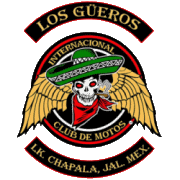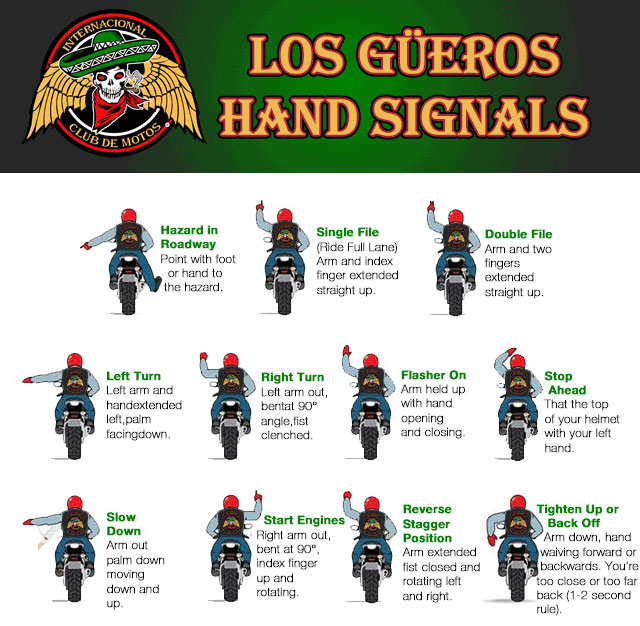
Hand Signals

Hand signals need to be passed back from the road captain all the way to the sweep. A break in this communication can lead to riders further back not being able to see and react to a road hazard in time.
Sometimes, signals will needed to be passed forward, especially for Flasher On and Stop Ahead. When you need to pass a signal forward, give a brief toot of your horn first, and then give the signal. The rider in front of you should know when he/she hears your horn to check mirrors for a hand signal.
Notes on Hand Signals
Usually you will use your foot to indicate a hazard on the right (you’ll want to keep your hand on the throttle) and your hand on the left hand side. You can of course use your foot on the left side as well.
Usually, we will ride in double file staggered format. Single file will be used when going through small towns, on twisty two lane roads, occasionally when passing slower traffic, and when road conditions are bad.
Occasionally there will be a car or other vehicle behind the group that is pressing to pass. For safety reasons, we want that vehicle to pass safely and not cut in the middle of the group. When this happens, the sweep will contact the road captain using the headset. The hand signal for this is the arm up with index finger extended, followed by pointing to the right. All riders should then move to the right of the lane, giving room for the vehicle to pass.
Once we have passed whatever reason the road captain deemed it best to ride single file, he’ll give the two fingers extended sign to return to staggered formation.
Use this for turns for intersections, on and off ramps, and lane changes.
Usually, it will be a rider behind you that notices you’ve forgotten to turn a turn signal off, so you will normally hear the honking of the horn behind you. Check your mirrors, and then of course turn the signal off.
There can be a variety of reasons any rider in the group may need to stop. They may need a bathroom/refreshment break, be low on gas, have a mechanical issue or other. This is another signal that will likely need to be passed forward up to the road captain. If passing the signal forward, give a brief honk of your horn and then tap the top of your helmet with your left hand. Once this signal has made it to the road captain leading the ride, he/she will acknowledge the signal by tapping his/her helmet.
The slow down may be given when there is a particularly bad road hazard ahead. Given that we ride with the 1-2 second rule, slowing down should happen without the need of this hand signal, so it is optional.
The road captain leading the ride will give the group the signal to start engines. You should give this signal back once your engine is started and you are ready to go.
If a rider leaves the group, each rider behind him/her will need to switch tire tracks in order to maintain the staggered position. Hold your left arm straight up, closed fist and rotate back and forth. Each rider behind you will to the same.
If the rider in front of you sees that you are consistently either too close or too far back from him/her (the 1 / 2 second rule), he/she will motion to you to either close or widen the gab. Close in has a hand sweeping forward gesture, and back off has a hand pushing back motion.